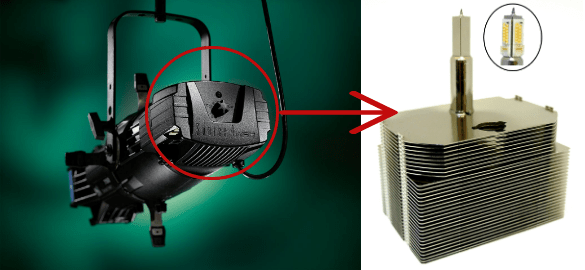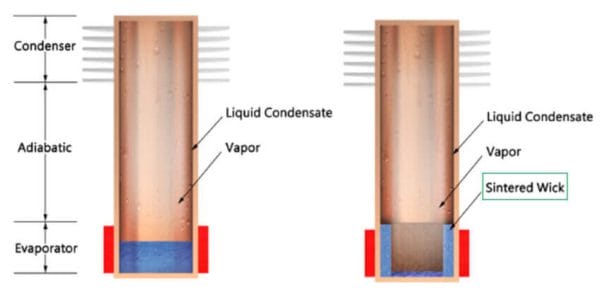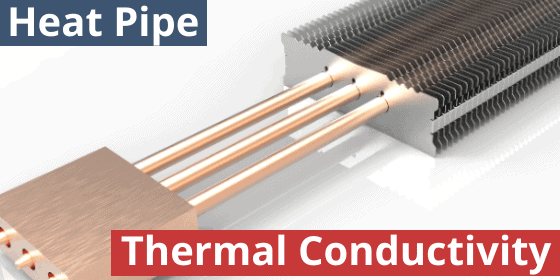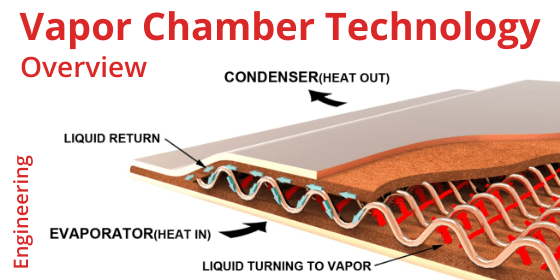Advanced Cooling Technologies
,The technologies for cooling modern electronics has advanced significantly over the past several decades. Driven by a combination of increased power output and shrinking die size, heat sink fin design, fan options, and TIM material have made giant leaps in improving thermal performance. However, this article only covers three of these advanced cooling technologies: heat pipes, vapor chambers, and thermosyphons.
Advanced Cooling Technology #1 – Heat Pipes
Unlike most heat sink manufacturers, Celsia regularly alters heat pipe wall and wick properties to fully optimize the heat sink for specific electronics cooling applications. Additionally, we are accustomed to modifying the physical characteristics of the heat pipes beyond bending and flattening.
Custom wick design and unique shape can be seen in the UHB LED application for theatrical lighting (below). Because the device has to operate efficiently in any orientation – heat pipe wick material properties like thickness and porosity/permeability are designed to provide adequate capillary pumping while assuring sufficient vapor cross-sectional area. In addition, a traditional round heat pipe needed to be square at one end to accommodate 4 high-brightness LED modules.

Custom Heat Pipe with Square End
Related Links:
Advanced Cooling Technology #2 – Vapor Chambers
Over a decade ago, Celsia advanced vapor chamber cooling technology by perfecting a new manufacturing technique that resulted in cost savings and new application options. Unlike traditional vapor chambers that are manufactured using two-stamped plates and copper column standoffs (two-piece design), Celsia’s one-piece design begins life as a very large tube of up to 70mm. These pipes are sintered and flattened after which a corrugated copper spacer and water are added and the device vacuum sealed. This manufacturing process not only reduces tooling cost but also allows the vapor chamber to be bent into L and U shapes – something unavailable with a traditional vapor chamber manufacturing process.
Like our heat pipes, all vapor chamber devices are custom built for each application. Pictured below is a unique Celsia vapor chamber design that’s really a hybrid of a low cost one-piece which are always rectangular in shape, and a two-piece design that allows for design flexibility along the X and Y axes.

Low Cost 1-Piece Vapor Chamber for Electronics Cooling
Related Links
Advanced Cooling Technology #3 – Thermosyphons (thermosiphons)
Thermosyphons differ from heat pipes and vapor chambers in that they are completely (most common) or almost entirely a wickless device. Because of this design, thermosyphons offer some compelling advantages when cooling electronics.

Wickless (L) and Partial Wick (R) Thermosyphons
First, thermosyphons are able to carry two to three times more heat (Qmax) than heat pipes of the same diameter. Put another way, a 3mm thermosyphon can have roughly the same Qmax as a 6mm heat pipe, allowing for a much more compact heat transport device. Second, these devices allow heat to be transported over a much longer distance than with heat pipes. While the practical limit for heat pipes is around 1 to 2 meters, thermosyphons can easily carry heat distances over 10 meters. This leads to an obvious question; why are heat pipes used at all?
Traditional heat pipes have a sintered wick bonded to the entirety of its inside walls. This allows the device to work against gravity while enabling operation using only a small amount of working fluid, much less than would be used in a thermosyphon. The consequences of thermosyphon design are twofold. First, they can only operate when the liquid-return phase is gravity aided – when the evaporator (heat source) is below the condenser (heat sink). Second, thermosyphons are subject to structural damage over time caused during repeated freeze/thaw cycles of the working fluid – this can be mitigated by using a partially wicked thermosyphon or using a working fluid different than water.
For more on thermosyphons, click here.
Incorporating advanced cooling technologies such as heat pipes, vapor chambers, or thermosyphons into heat sink designs are particularly important in space constrained devices, high heat flux applications, rugged environments, and situations where heat needs to be moved long distances.
Contact us today to compare pricing on your existing products or have us quote a new heat sink design based on one of these cooling technologies.










